
Alopecurus aequalis is a common species of grass known as shortawn foxtail or orange foxtail. It is native to much of the temperate Northern Hemisphere from Eurasia to North America. It is most commonly found in areas near fresh water, such as the margins of ponds and ditches.

Carex lenticularis is a species of sedge known by the common names lakeshore sedge and goosegrass sedge. It is native to much of northern North America, including most all of Canada and the western United States, where it grows in wet habitats.

Carex mariposana is a species of sedge known by the common name Mariposa sedge.
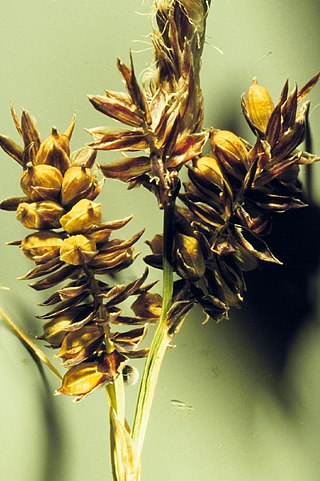
Carex raynoldsii is a species of sedge known by the common name Raynolds' sedge. It is native to western North America and grows in alpine to subalpine meadows.
Carex sheldonii is a species of sedge known by the common name Sheldon's sedge.
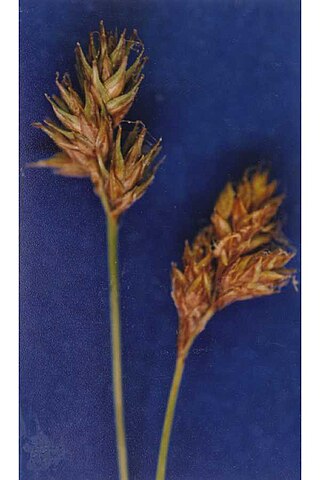
Carex straminiformis is a species of sedge known by the common name Shasta sedge.
Carex acutata is a species of sedge, a flowering plant in the family Cyperaceae. It was first formally named by Francis Boott in 1846. Carex acutata is native to South America. In Bolivia it occurs at elevations of 3,500–4,000 m (11,500–13,100 ft).
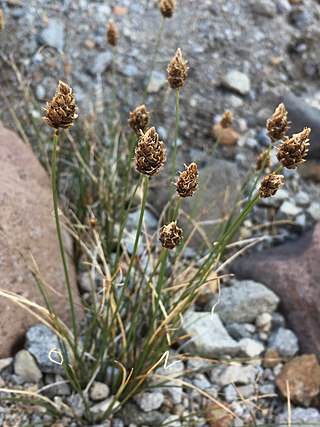
Carex breweri, known as Brewer's sedge, is a species of sedge that grows on dry rocky or gravel slopes in the Sierra Nevada and Cascade Mountains of the western United States, as far north as Mount Hood. It is classified in Carex sect. Inflatae, alongside Carex engelmannii and Carex subnigricans.
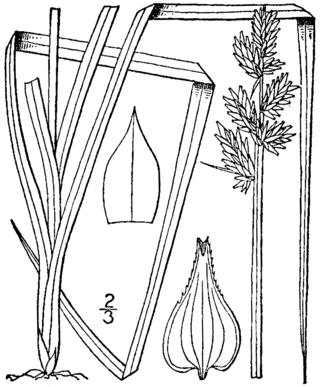
Carex conjuncta, known as soft fox sedge, is a species of sedge that was first formally named by Francis Boott in 1862. It is endemic to the central and eastern United States.

Carex rariflora, the looseflower alpine sedge, is a species of plant in the sedge family. It is found in the United States in Alaska and Maine, and in Canada in New Brunswick and Nova Scotia. In these regions, it is ranked as an obligate hydrophyte in establishing wetland areas. It prefers wet environments such as open bogs, meadows, seepage slopes, and low-elevation heath tundra. This perennial grass, which can be up to 3 feet tall, has fibrous roots, and holds all perennial organs underground. The leaves are alternate, long, narrow, and simple, with parallel veins. They grow in dense clusters, and the dead leaves are found at the base of the plant. The plant blooms and fruits in the summer. All flowers are monoecious and unisexual, producing a spike inflorescence. All inflorescences are subtended by shorter, proximal bracts.
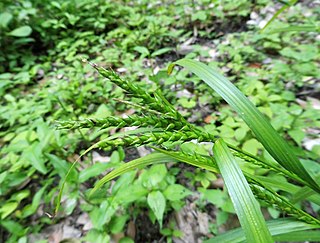
Carex ischnostachya is an herbaceous graminoid plant in the sedge family (Cyperaceae). It is native to the eastern Asia, where it is found in China, Japan, and Korea. Its natural habitat is in forest openings in wet areas, in hills or mountains. It is a common species, and is often found along roadsides or trails.

Carex brunnea, the greater brown sedge, is a small species of plant found in many parts of Asia, as well as eastern Australia and Lord Howe Island. This plant is often seen in disturbed, sunny areas in and near rainforest. This is one of many plants described by Robert Brown and was published in his Prodromus Florae Novae Hollandiae et Insulae Van Diemen (1810). Brown recorded the type "(J.) v.v." Brown's name of Carex gracilis was ruled invalid, as the plant had previously appeared in scientific literature in 1784. Published by the Swedish naturalist Carl Peter Thunberg, in Murray's Systema Vegetabilium, 14th edition.
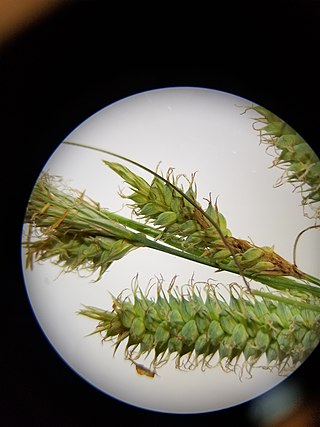
Carex glaucescens is a perennial sedge that belongs to the family Cyperaceae. The common name of this sedge is the southern waxy sedge due to the blue-grey, waxy appearance of the sheaths and fruits. The term "glaucous" means "gleaming" or "grey" in Latin; the specific epithet of C. glaucescens is derived from this term. Carex glaucescens is a native plant in North America and is an obligate wetland species in the Atlantic and Gulf Coastal Plains, Eastern Mountains and Piedmont, and the Great Plains.

Carex muehlenbergii is a species of flowering plant, it is a type of sedge. It is a grass-like plant in the family Cyperaceae. Its common names include sand sedge, Muhlenberg's sedge.
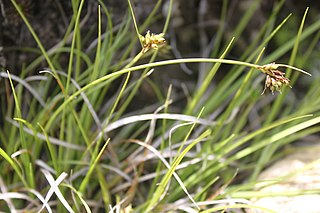
Carex deflexa, the northern sedge, is a cespitose sedge with purplish brown to reddish brown rhizomes and pale green leafs that are often shorter than stems and 0.9–2.6 mm wide.

Carex fuliginosa, the short-leaved sedge, is a species of flowering plant in the family Cyperaceae, with a circumpolar distribution, and found in mountains further south; such as the eastern Alps, the Carpathians and the Rockies. It is wind-pollinated.
Carex crebriflora, the coastal plain sedge, is a species of flowering plant in the family Cyperaceae, native to Texas and the southeastern United States. It is typically found growing less than 100 m (330 ft) above sea level in the understory of wet deciduous or mixed deciduous-evergreen forests, preferring alluvial, sandy soils.
Carex interrupta is a tussock-forming species of perennial sedge in the family Cyperaceae. It is native to south eastern parts of Canada and north eastern parts of the United States.
Carex ozarkana, the Ozark sedge, is a species of flowering plant in the family Cyperaceae, native to the U.S. states of Oklahoma, Texas, Arkansas, and Louisiana. A perennial forming loose tufts and reaching 110 cm (43 in), it is found growing in permanently wet soils.
Carex bonanzensis, the Yukon sedge, or the bonanza sedge, is a species of sedge in the family Cyperaceae. It was described by Nathaniel Lord Britton in 1901.













